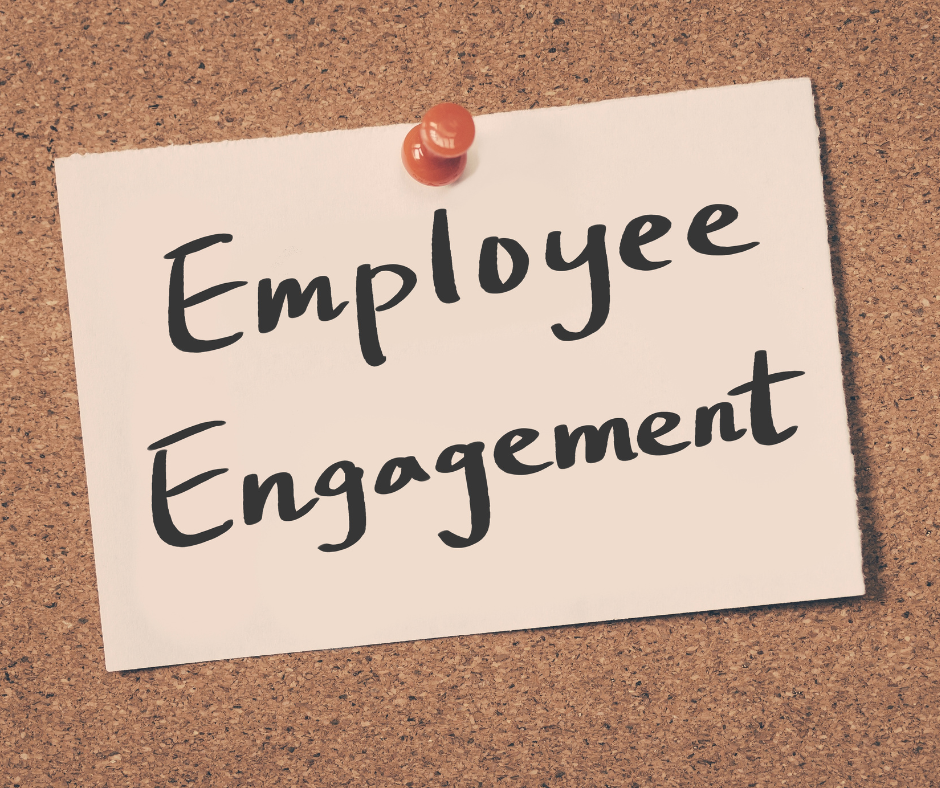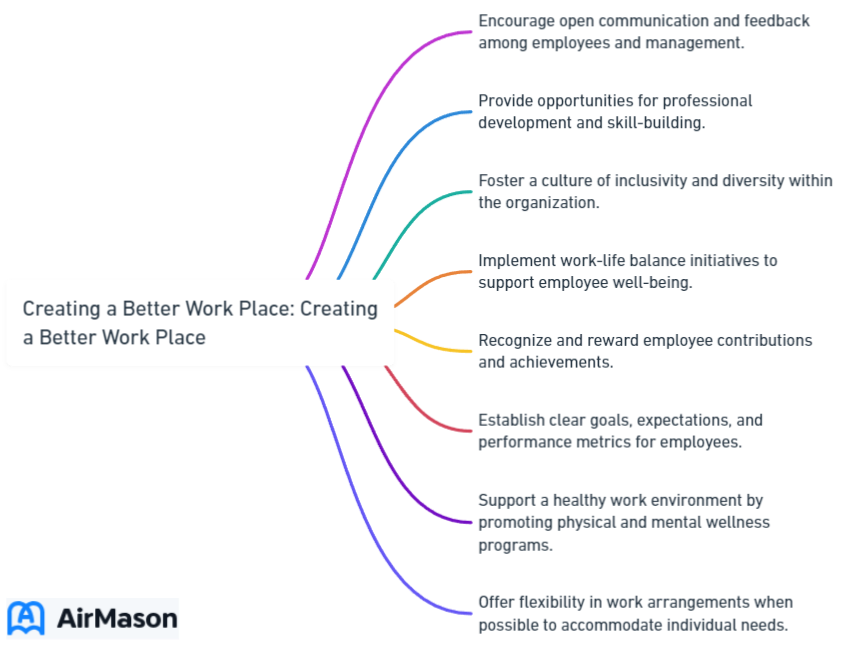
Welcome to the modern workplace, where employee engagement and happiness are at the forefront of every organization’s mind. Gone are the days of drab office spaces and lackluster work culture. Today’s successful companies understand that a better work place leads to better outcomes for both employees and the organization itself. In this blog post, we will delve into strategies that have been proven to create a thriving work environment where employees feel valued, motivated, and excited to contribute their best.
Join us on this journey to discover the keys to unlocking employee engagement and happiness, from fostering a positive work environment to enhancing employee development and promoting work-life balance. Let’s dive in and explore how these strategies can transform your organization into a place where employees don’t just work, but thrive.
Key Takeaways
- Foster positive work environment with open communication and strong relationships
- Encourage employees to share ideas and be part of decision making process
- Prioritize mental health, recognize hard work, embrace remote/hybrid models & leverage technology for collaboration
The Importance of Employee Engagement
What makes a better workplace? It starts with engaged employees. Employee engagement has a profound impact on productivity, job satisfaction, and employee retention. After all, when employees feel valued and connected to their work, they are more likely to be motivated, committed, and loyal to the organization. This, in turn, leads to a positive work culture that attracts new employees and keeps existing ones happy and content.
Most employees want more than just a paycheck. They want to feel that their work is meaningful and contributes to the overall success of the company. Engaged employees are more likely to go the extra mile, provide exceptional customer experiences, and collaborate effectively with their co-workers. This blog post will uncover strategies to enhance employee engagement, starting with fostering a positive work environment.

Fostering a Positive Work Environment
A positive work environment is the foundation for employee engagement and happiness. We will delve into the strategies for creating a positive work environment, which includes promoting open communication, fostering co-worker relationships, and prioritizing mental health and well-being.
Implementing these strategies can help cultivate a workplace culture that bolsters employee morale, job satisfaction, and productivity.
Encourage Employees to Share Ideas
One of the most effective ways to foster employee morale and create a better workplace is to encourage employees to share their ideas and contribute to the decision-making process. When employees feel that their voices are heard and valued, they are more likely to feel a sense of ownership and belonging in the organization. This, in turn, can lead to increased employee engagement and employee happiness, resulting in higher productivity.
Establishing a welcoming environment for idea sharing is integral. Some successful companies that excel in this area include Xerox, PepsiCo, Patagonia, Johnson & Johnson, Google, and IKEA. These companies have implemented various strategies, such as actively listening to employees, leading with enthusiasm, appreciating all ideas, offering rewards, creating a feedback-friendly atmosphere, inspiring innovative thinking, and asking thought-provoking questions. By learning from their success, you can empower your employees to share their ideas and contribute to the company’s growth.
Build Relationships with Co-workers
Fostering relationships among co-workers is vital for a collaborative, trust-based, and supportive work culture. When employees feel connected to their colleagues, they are more likely to engage in open communication, share ideas, and work together effectively. This not only boosts job satisfaction but also contributes to the overall success of the organization.
One inspiring example of relationship building within a company is SnackNation’s partnership with Feeding America. Through this partnership, every time a SnackNation box is delivered, 10 meals are provided to a hungry family in the United States. This initiative not only makes a positive impact on the community but also aligns with the company’s business strategy, fostering a sense of camaraderie and purpose among employees. By implementing similar strategies within your organization, you can cultivate strong relationships among co-workers and promote a positive work environment.
Prioritize Mental Health and Well-being
In the hustle and bustle of today’s world, giving priority to mental health and well-being in the workplace has never been more significant. By providing valuable resources and support for employees to manage stress and maintain a fulfilling work-life balance, employers can create a positive work environment where employees feel valued and cared for.
One effective strategy for promoting mental health in the workplace is to introduce an employee health and wellness plan. Employers can also optimize mental health support by:
- Setting a positive example
- Offering flexibility in work arrangements
- Making mental health resources available
- Equipping managers with the knowledge to recognize signs of mental health issues
- Increasing awareness through education and training programs
- Encouraging physical and emotional health through activities like exercise and wellness programs
By prioritizing mental health and well-being, you can ensure a thriving and supportive workplace for all employees.
An Organization’s Culture
An organization’s culture encompasses the shared values, beliefs, and practices that shape its identity and guide the behavior of its members. It forms the bedrock upon which the company’s mission and vision are built, influencing every aspect of its operations. This cultural framework sets the tone for how employees interact, make decisions, and pursue the organization’s goals. A strong organizational culture fosters a sense of belonging and purpose among team members, driving them to work cohesively towards common objectives. Conversely, a mismatch between an individual’s values and the prevailing culture can lead to disengagement and reduced productivity. Therefore, understanding and nurturing an organization’s culture is paramount in creating a thriving and harmonious work environment.
Enhancing Employee Development

Employee development is another crucial aspect of creating a better workplace. When employees are provided with opportunities for growth and development, they are more likely to feel motivated and engaged in their work.
We will delve into strategies for enhancing employee development, such as aligning personal growth with company objectives, offering continuous learning opportunities, and initiating mentoring and coaching programs.
Aligning Personal Growth with Company Goals
A vital component to boost employee engagement and motivation is to synchronize personal growth with the company’s mission and objectives. By doing so, employees feel that their individual development is directly connected to the success of the organization. This sense of purpose drives employees to reach their full potential and contribute more effectively to the company’s objectives.
To optimally align personal growth with company goals, employers can provide clear expectations and guidance, set measurable objectives, and offer support through resources, training, and feedback. By aligning employee development with the organization’s goals, you can create a win-win situation where both employees and the company thrive.
Providing Continuous Learning Opportunities
Providing continuous learning opportunities forms another crucial part of employee development. By providing employees with the chance to develop new skills and stay up-to-date with industry trends, you can foster a culture of growth and innovation within your organization. This not only benefits the employees but also enhances the overall success of the company.
Some shining examples of organizations that have successfully implemented continuous learning programs include:
- IBM
- Formlabs
- Reed
- Abstracta
- Goldman Sachs
By learning from these organizations and offering your employees exciting learning opportunities, you can cultivate a culture of growth and development that benefits both employees and the company as a whole.
Mentoring and Coaching Programs
Supporting employee growth and development can also be achieved effectively through mentoring and coaching programs. These programs can help employees develop new skills, boost their confidence, and build strong relationships with colleagues. By offering a variety of mentoring and coaching options, such as one-on-one mentoring, group mentoring, and peer coaching, you can cater to the diverse needs of your employees.
To implement successful mentoring and coaching programs, it is essential to:
- Identify clear goals
- Thoughtfully select mentors and coaches
- Create a program structure that works
- Effectively evaluate the program
By investing in mentoring and coaching programs, you can enhance employee development and contribute to a better workplace for all.
Work-Life Balance Strategies

Work-life balance is an essential factor in creating a better workplace where employees feel valued and engaged. We will discuss strategies to promote work-life balance, such as implementing flexible working arrangements, encouraging use of time off and vacations, and introducing wellness programs.
Prioritizing work-life balance aids employees in maintaining a healthy and fulfilling life, both professionally and personally.
Flexible Working Arrangements
Flexible working arrangements serve as a potent method to accommodate personal needs and preferences of employees, thereby enhancing the workplace environment. Some examples of flexible working arrangements include:
- Remote work
- Condensed workweeks
- Flextime
- Part-time work
These arrangements can help employees balance their personal and professional lives.
Flexible working arrangements not only benefit employees, but they also offer advantages to the organization. Research has shown that employees who have the option to work remotely or adjust their schedules are more likely to be satisfied, loyal, and productive. By embracing flexible working arrangements, you can create a workplace that caters to the diverse needs of your employees, ultimately fostering a better workplace for all.
Encouraging Time Off and Vacation Usage
Maintaining a healthy work-life balance necessitates encouraging employees to take time off and utilize their vacation days. Taking regular breaks and vacations can improve well-being, reduce stress and burnout, and ultimately lead to increased productivity and job satisfaction.
Employers can motivate employees to make the most of their vacation days by offering flexible working arrangements, providing incentives for taking time off, and implementing wellness programs. By setting boundaries and expectations around taking time off, you can ensure that employees take the necessary breaks to recharge and maintain a positive work-life balance.
Implementing Wellness Programs
The introduction of wellness programs stands as another effective way to promote work-life balance and foster a superior workplace. Wellness programs can include:
- Yoga classes
- Healthy lunch and snack options
- Fitness activities
- Financial counseling
- Smoking cessation programs
- On-site fitness centers
- Paramedical services
- Transit options
These programs not only promote physical and mental health among employees but also demonstrate that the organization values their well-being.
To ensure that wellness programs are accessible to all employees in a positive way, it is essential to emphasize diversity, inclusivity, and communication. By offering wellness programs that cater to the diverse needs of your employees, you can create a supportive and healthy workplace environment where employees can thrive.
A Collaborative Business Culture is Characterized by
A collaborative business culture is characterized by an environment where employees work together seamlessly towards common goals. This type of culture fosters open communication, encourages knowledge sharing, and promotes a sense of unity among team members. In a collaborative culture, individuals value each other’s contributions and are willing to offer support and feedback. Moreover, decision-making is often a collective effort, with input sought from various stakeholders. This inclusive approach not only leads to innovative solutions but also cultivates a sense of ownership and commitment among employees, ultimately driving the organization towards success.
Recognizing and Rewarding Hard Work

Acknowledging and rewarding hard work is fundamental in fostering a company culture where employees feel valued and driven. We will delve into strategies to recognize and reward hard work via employee recognition programs and performance incentives. By implementing these strategies, you can create an environment where employees feel appreciated for their contributions and are inspired to continue delivering their best.
Establishing Employee Recognition Programs

Employee recognition programs serve as an effective method to appreciate and honor employees’ achievements and contributions. By establishing a well-designed recognition program, you can create a positive work environment where employees feel valued and motivated.
Some key elements of an effective employee recognition program include:
- Human interaction
- Peer recognition
- Useful and desirable awards
- Family involvement
- Immediate gratification
Successful employee recognition programs in large companies, such as Zappos, provide excellent examples of how to implement these elements. By learning from these companies and establishing a comprehensive recognition program, you can create a better workplace where employees feel appreciated for their hard work.
Offering Incentives for Performance
Providing performance incentives like bonuses, promotions, or other rewards presents another compelling way to motivate employees and acknowledge their efforts. Performance incentives not only boost employee morale but also increase retention rates.
To create a fair and effective performance incentive program, it is essential to:
- Align incentives with organizational goals
- Evaluate performance objectively
- Offer diverse incentives
- Promote transparency
By offering performance incentives that are meaningful and equitable, you can create a workplace where employees feel valued and motivated to contribute their best.
Adapting to Changing Workplace Trends

The ever-changing landscape of the workplace requires organizations to adapt and evolve to stay competitive and foster a better workplace. We will discuss strategies to adapt to evolving workplace trends, which includes embracing remote work and hybrid models, along with leveraging technology for collaboration and communication.
By staying ahead of the curve and adapting to these trends, you can create a modern and dynamic workplace that meets the needs of your employees.
Embracing Remote Work and Hybrid Models

With the growing popularity of remote work and hybrid models in recent years, employees can enjoy the flexibility and convenience of working from home or other remote locations while still maintaining in-person collaboration. Embracing these models not only accommodates employees’ preferences but also allows organizations to adapt to the changing work landscape.
The advantages of remote work and hybrid models include enhanced productivity, improved work-life balance, and cost savings. To successfully implement remote work and hybrid models, it is important to set clear expectations, provide the necessary tools and resources, and foster a culture of trust and collaboration. By embracing these models, you can create a better workplace that caters to the diverse needs of your employees.
Leveraging Technology for Collaboration and Communication
In the digital era, it’s vital to utilize technology for collaboration and communication to keep employees connected and engaged, irrespective of their work location. By utilizing tools and platforms such as:
- Zoom
- Microsoft Teams
- Slack
- Google Meet
Employers can facilitate remote collaboration and virtual meetings, ensuring that employees feel part of the team even when they are not in the same room.
In addition to these popular tools, there are many other innovative solutions available for virtual communication and collaboration. Digital whiteboards, real-time document collaboration tools, and simulated office environments like Gather can all help promote effective communication and collaboration among remote teams.
By leveraging technology, you can create a connected and engaged workforce that thrives in today’s rapidly changing workplace environment.
Culture Vision Statement Examples
When it comes to crafting impactful organizational cultures, examining culture vision statement examples serves as an invaluable starting point. These statements encapsulate the ethos and aspirations that define a company’s cultural landscape. For instance, a technology giant might emphasize innovation, collaboration, and global connectivity in its culture vision statement, fostering an environment of cutting-edge creativity and teamwork. Conversely, a boutique design agency’s vision statement may highlight artistic excellence, individuality, and a close-knit community, cultivating a space where unique talents flourish. In the realm of healthcare, a hospital’s culture vision statement could prioritize empathy, patient-centric care, and continuous improvement, fostering an atmosphere of compassion and dedication to excellence in healing. Such examples not only serve as guideposts for employees, but also resonate with clients, partners, and stakeholders, reinforcing the core values that underpin an organization’s identity. Ultimately, culture vision statement examples are more than mere words; they are blueprints for the kind of environment a company strives to create and sustain.
Summary
Throughout this blog post, we have explored various strategies for creating a better workplace, including fostering a positive work environment, enhancing employee development, promoting work-life balance, recognizing and rewarding hard work, and adapting to changing workplace trends. By implementing these strategies, you can cultivate a thriving work culture where employees feel valued, engaged, and motivated to contribute their best.
Ultimately, the key to creating a better workplace lies in understanding and addressing the diverse needs of your employees. By prioritizing employee engagement and happiness, you can build a strong foundation for organizational success and create a workplace where employees don’t just work, but truly flourish.
Frequently Asked Questions
What makes for a better workplace?
Creating a better workplace involves rewarding accomplishments, incentivizing wellness, offering beneficial benefits, having competitive salaries and benefits packages, providing work space and privacy, making the office more comfortable, and improving communication. Additionally, hosting company events and expressing gratitude are also important elements that contribute to building trust, enthusiasm, and a positive company culture.
What are the 3 most important things in a working environment?
Creating a positive work environment with respect, teamwork, and training is essential for a successful workplace. Communication and opportunities to grow are also important factors for fostering an effective team.
What is a healthy workplace environment?
A healthy workplace is one where employees feel heard, appreciated, and supported in their efforts. It provides a safe environment where healthy behaviors are promoted and encouraged and conversations with coworkers are respectful and compassionate.
What are the 3 types of work environment?
The five most popular types of work environment are a comfortable work environment, traditional work environment, flexible work environment, remote work environment, and modern work environment. These different environments allow individuals to create the best possible conditions for themselves and their team to support the needs and wants of themselves, others, or a wider community.
What are some effective strategies to foster a positive work environment?
Encouraging open communication, building relationships among co-workers, and prioritizing mental health and well-being are some effective strategies to foster a positive work environment that allows employees to thrive.